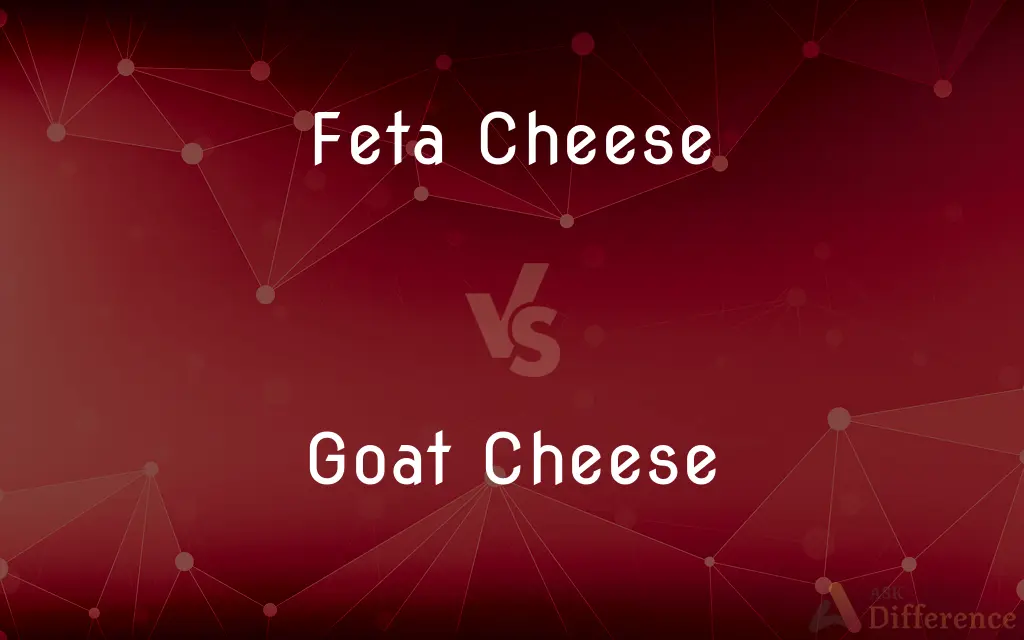Feta Cheese vs. Goat Cheese — What's the Difference?
Edited by Tayyaba Rehman — By Fiza Rafique — Published on December 20, 2023
Feta Cheese is a brined curd cheese from sheep’s milk (or a mix with goat’s), Greek origin. Goat Cheese is a cheese made entirely from goat’s milk, various forms and flavors.

Difference Between Feta Cheese and Goat Cheese
Table of Contents
ADVERTISEMENT
Key Differences
Feta Cheese is a specific variety of cheese originating from Greece, traditionally made from sheep's milk or a combination of sheep's and goat's milk. Goat Cheese refers to any cheese made exclusively from goat's milk, offering a wide range of cheese types from different regions worldwide.
Feta Cheese is characteristically tangy, with a crumbly texture and is stored in brine, giving it a salty flavor profile. Goat Cheese, on the other hand, encompasses various textures and flavors, from soft and creamy to hard and pungent, depending on the production methods.
Feta Cheese has Protected Designation of Origin (PDO) status, meaning that only cheese produced in a traditional way in particular areas of Greece can be called 'feta'. Goat Cheese does not typically have such restrictions, leading to a broader variety of products and regional styles.
Feta Cheese is commonly used in Mediterranean cuisine, known for its distinct flavor that holds up well in cooked dishes or salads. Goat Cheese is versatile, used in numerous culinary applications worldwide, from spreading on bread to topping pizzas, enhancing salads, or being served as part of a cheese platter.
Both Feta Cheese and Goat Cheese offer nutritional benefits, including a good amount of protein, calcium, and vitamins. However, Feta Cheese generally has a higher sodium content due to its brining process, while Goat Cheese may be easier to digest for people with sensitivities to cow's milk.
ADVERTISEMENT
Comparison Chart
Primary Ingredient
Sheep's milk or a mix with goat's milk
Goat's milk
Origin
Greece
Various, no specific origin
Texture and Flavor
Crumbly, tangy, salty
Ranges from creamy to crumbly, mild to pungent
Designation
Protected Designation of Origin (PDO)
No specific designation
Uses
Salads, cooked dishes, Mediterranean cuisine
Diverse culinary applications worldwide
Compare with Definitions
Feta Cheese
Feta Cheese is known for its firm, crumbly texture and is used in a variety of dishes.
The Feta Cheese crumbled beautifully over the top of the savory pastry.
Goat Cheese
Goat Cheese is often considered easier to digest than cheese made from cow’s milk, suitable for some with lactose sensitivities.
I prefer Goat Cheese as it’s gentler on my stomach than other dairy products.
Feta Cheese
Feta Cheese is a PDO-protected product, ensuring it's produced using traditional methods in specific areas of Greece.
I always check the label to make sure my Feta Cheese is a certified PDO product.
Goat Cheese
Goat Cheese is known for its tart, earthy flavor, which can vary depending on its aging process.
The aged Goat Cheese had a bolder, more complex flavor than the fresh variety.
Feta Cheese
Feta Cheese is typically made from sheep’s milk or a combination of sheep’s and goat’s milk.
The authentic Feta Cheese in the market was made from pure sheep’s milk.
Goat Cheese
Goat Cheese is versatile, used in both savory and sweet dishes across various cuisines.
The tangy Goat Cheese was a delightful contrast to the sweet, crisp apples.
Feta Cheese
Feta Cheese has a tangy and salty flavor due to the brine solution it’s stored in.
The Feta Cheese added a perfect salty bite to the Mediterranean dish.
Goat Cheese
Goat Cheese comes in various forms, ranging from soft, fresh cheese to hard, aged cheese.
For the cheese board, I selected a variety of Goat Cheese, each offering a unique texture.
Feta Cheese
Feta Cheese is a brined, white cheese traditionally made in Greece.
The salad was topped with crumbly Feta Cheese, adding a tangy, salty flavor.
Common Curiosities
What is Feta Cheese?
Feta Cheese is a Greek brined cheese made primarily from sheep’s milk or a mix with goat’s milk.
Is Feta Cheese suitable for lactose-intolerant individuals?
Feta Cheese has lower lactose levels than some cheeses, but sensitivity varies.
Is Goat Cheese made from cow's milk?
No, Goat Cheese is made specifically from goat’s milk.
How should Feta Cheese be stored?
Feta Cheese should be stored in a brine or milk bath in the refrigerator.
Does Goat Cheese melt well?
Goat Cheese melts smoothly, making it great for cooking.
Can you eat the rind of Feta Cheese?
Feta Cheese doesn’t have a rind; the entire cheese is edible.
What makes Feta Cheese different from other cheeses?
Feta Cheese is unique in its tangy, salty flavor, crumbly texture, and PDO status.
How long can Goat Cheese last in the fridge?
Sealed, fresh Goat Cheese can last up to two weeks; aged varieties, longer.
What's the texture of Goat Cheese?
Goat Cheese ranges from soft and spreadable to firm and crumbly, depending on the type.
Is Goat Cheese healthier than cow's cheese?
Goat Cheese has fewer lactose and different proteins, potentially making it easier to digest.
Can Goat Cheese be used in desserts?
Yes, Goat Cheese's creamy texture and tart flavor work well in many desserts.
Is Feta Cheese always made with sheep's milk?
Traditionally, yes, though some varieties mix in goat's milk.
What does Goat Cheese taste like?
Goat Cheese has a tart, sometimes earthy flavor, varying with age and type.
Does Feta Cheese melt when cooked?
Feta Cheese holds its shape when heated, getting softer but not melting completely.
Is Feta Cheese keto-friendly?
Yes, Feta Cheese is low in carbs and keto-friendly.
Share Your Discovery

Previous Comparison
RAID 0 vs. RAID 1
Next Comparison
Conjugal Family vs. Consanguine FamilyAuthor Spotlight
Written by
Fiza RafiqueFiza Rafique is a skilled content writer at AskDifference.com, where she meticulously refines and enhances written pieces. Drawing from her vast editorial expertise, Fiza ensures clarity, accuracy, and precision in every article. Passionate about language, she continually seeks to elevate the quality of content for readers worldwide.
Edited by
Tayyaba RehmanTayyaba Rehman is a distinguished writer, currently serving as a primary contributor to askdifference.com. As a researcher in semantics and etymology, Tayyaba's passion for the complexity of languages and their distinctions has found a perfect home on the platform. Tayyaba delves into the intricacies of language, distinguishing between commonly confused words and phrases, thereby providing clarity for readers worldwide.












































